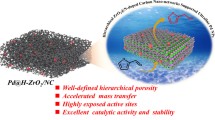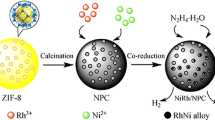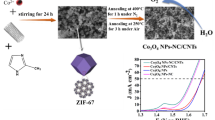Abstract
Two-dimensional (2D) porous carbon nanosheets (PCNs) have attracted great attention for their combining both the unique properties of 2D materials and the porous features, but the synthesis of PCNs in a simple yet efficient way still remains a great challenge. Herein, N-doped porous two-dimensional carbon nanosheets (NPCNs) with high surface area and pore volume were fabricated successfully by using graphitic carbon nitride (g-C3N4) as a self-sacrificial template. Compared with ZIF-8 only derived microporous carbon supported Ru catalyst, Ru/NPCNs exhibit much higher catalytic performance for the hydrogenation of benzoic acid, giving a TOF of 1136.6 h−1 at 80 °C and 1 MPa H2. This work may provide a new choice for the synthesis of porous two-dimensional carbon nanosheets that possess a promising candidate as the catalyst support.
Graphical Abstract
N-doped porous two-dimensional carbon nanosheets (NPCNs) with high surface area and pore volume were fabricated. Ru/NPCNs exhibited high catalytic performance for the hydrogenation of benzoic acid, giving a TOF of 1136.6 h−1 at 80 °C and 1 MPa H2.







Similar content being viewed by others
References
Mizuno N, Misono M (1998) Heterogeneous catalysis. Chem Rev 98(1):199–218
Hagen J (2015) Industrial catalysis: a practical approach. Wiley, NewYork
Cao Y et al (2017) Metal/Porous carbon composites for heterogeneous catalysis: old catalysts with improved performance promoted by N-doping. ACS Catal 7(12):8090–8112
Zhang L et al (2020) Selective hydrogenation over supported metal catalysts: from nanoparticles to single atoms. Chem Rev 120(2):683–733
Pinna F (1998) Supported metal catalysts preparation. Catal Today 41(1–3):129–137
Gates BC et al (2017) Atomically dispersed supported metal catalysts: perspectives and suggestions for future research. Catal Sci Technol 7(19):4259–4275
Baek IG, You SJ, Park ED (2012) Direct conversion of cellulose into polyols over Ni/W/SiO2-Al2O3. Bioresour Technol 114:684–690
Cao Y et al (2020) Biomass-derived N-doped porous two-dimensional carbon nanosheets supported ruthenium as effective catalysts for the selective hydrogenation of quinolines under mild conditions. Catal Commun 143:106048
Makosch M et al (2012) Hydrogenation of nitrobenzene over Au/Meox catalysts-A matter of the support. ChemCatChem 4(1):59–63
Auer E et al (1998) Carbons as supports for industrial precious metal catalysts. Appl Catal A-Gen 173(2):259–271
Lee J, Kim J, Hyeon T (2006) Recent progress in the synthesis of porous carbon materials. Adv Mater 18(16):2073–2094
Titirici MM et al (2015) Sustainable carbon materials. Chem Soc Rev 44(1):250–290
Rodríguez-reinoso F (1998) The role of carbon materials in heterogeneous catalysis. Carbon 36(3):159–175
Lam E, Luong JHT (2014) Carbon materials as catalyst supports and catalysts in the transformation of biomass to fuels and chemicals. ACS Catal 4(10):3393–3410
Li M et al (2016) Nitrogen-doped porous carbon materials: promising catalysts or catalyst supports for heterogeneous hydrogenation and oxidation. Catal Sci Technol 6(11):3670–3693
Shen K et al (2016) Development of MOF-derived carbon-based nanomaterials for efficient catalysis. ACS Catal 6:5887–5903
Cao Y et al (2020) In situ-formed cobalt embedded into N-doped carbon as highly efficient and selective catalysts for the hydrogenation of halogenated nitrobenzenes under mild conditions. Appl Catal A-Gen 592:117434
Cao Y et al (2020) Water-assisted one-pot synthesis of N-doped carbon supported Ru catalysts for heterogeneous catalysis. Chem Comm 56(76):11311–11314
Paraknowitsch JP, Thomas A (2013) Doping carbons beyond nitrogen: an overview of advanced heteroatom doped carbons with boron, sulphur and phosphorus for energy applications. Energy Environ Sci 6(10):2839–2855
Chen W et al (2019) Heteroatom-doped carbon materials: synthesis, mechanism, and application for sodium-ion batteries. Small Methods 3(4):1800323
Xuan C et al (2018) From a ZIF-8 polyhedron to three-dimensional nitrogen doped hierarchical porous carbon: an efficient electrocatalyst for the oxygen reduction reaction. J Mater Chem A 6(23):10731–10739
Zheng X et al (2015) Two-dimensional porous carbon: synthesis and ion-transport properties. Adv Mater 27(36):5388–5395
He Y et al (2019) Porous carbon nanosheets: synthetic strategies and electrochemical energy related applications. Nano Today 24:103–119
Xu X et al (2014) Hydrogenation of benzoic acid and derivatives over Pd nanoparticles supported on N-doped carbon derived from glucosamine hydrochloride. ACS Catal 4(9):3132–3135
Cao Y et al (2017) In situ synthesis of chitin-derived Rh/N-C cataylsts: efficient hydrogenation of benzoic acid and derivatives. ACS Sustainable Chem Eng 5(11):9894–9902
Zhang H et al (2017) Highly dispersed and stable Ni/mSiO2-AE nanocatalyst for benzoic acid hydrogenation. Catal Sci Technol 7(4):5993–5999
Lu X et al (2018) Selective hydrogenation of benzoic acid to cyclohexane carboxylic acid over microwave-activated Ni/carbon catalysts. Mol Catal 444:53–61
Zhang H et al (2019) In-situ generated highly dispersed nickel nanoclusters confined in MgAl mixed metal oxide platelets for benzoic acid hydrogenation. J Catal 372:258–265
Ren X et al (2019) Microenvironment engineering of ruthenium nanoparticles incorporated into silica nanoreactors for enhanced hydrogenations. Angew Chem Int Ed 58(41):14483–14488
Chaudhari C et al (2019) Recyclable Rh-PVP nanoparticles catalyzed hydrogenation of benzoic acid derivatives and quinolines under solvent-free conditions. Catal Commun 126:55–60
Chen X et al (2020) Hydrogenation of benzoic acid to benzyl alcohol over Pt/SnO2. Appl Catal A-Gen 593:117420
Guo M et al (2021) Hydrogenation of benzoic acid derivatives over Pt/TiO2 under mild conditions. Commun Chem 4(1):1–10
Zhao S et al (2021) Microcalorimetric adsorption and infrared spectroscopic studies of supported Pd, Ru and Pd-Ru catalysts for the hydrogenation of aromatic rings with carboxyl groups. Catal Sci Technol 11(9):3070–3083
Kim M et al (2021) KOH-activated hollow ZIF-8 derived porous carbon: nanoarchitectured control for upgraded capacitive deionization and supercapacitor. ACS Appl Mater Interfaces 13(44):52034–52043
Tang M et al (2015) RuPd alloy nanoparticles supported on N-doped carbon as an efficient and stable catalyst for benzoic acid hydrogenation. ACS Catal 5(5):3100–3107
Chetty R et al (2009) Effect of reduction temperature on the preparation and characterization of Pt-Ru nanoparticles on multiwalled carbon nanotubes. Langmuir 25(6):3853–3860
Tada S et al (2011) Effect of reduction pretreatment and support materials on selective CO methanation over supported Ru catalysts. Appl Catal A-Gen 404(1–2):149–154
Acknowledgements
We acknowledge financial support from the National Natural Science Foundation of China (No. 21878243 and No. 22002120), the Natural Science Foundation of Chongqing China (No. cstc2020jcyj-msxmX0750), the Guangdong Basic and Applied Basic Research Foundation (No. 2019A1515110507), the Key Research and Development Program of Shaanxi (No. 2022GY-153), the Undergraduate Training Program for Innovation and Entrepreneurship of Northwestern Polytechnical University (No. XN2021052),the Foundation of State Key Laboratory of High-efficiency Utilization of Coal and Green Chemical Engineering (Grant No. 2022-K50) , as well as the Innovation and practice ability training project for postgraduates of Xi’an Shiyou University (YCS19211019).
Author information
Authors and Affiliations
Corresponding authors
Additional information
Publisher's Note
Springer Nature remains neutral with regard to jurisdictional claims in published maps and institutional affiliations.
Supplementary Information
Below is the link to the electronic supplementary material.
Rights and permissions
About this article
Cite this article
Qiu, Z., Ma, S., He, X. et al. Nitrogen-Doped Porous Two-dimensional Carbon Nanosheets Derived from ZIF-8 as Multifunctional Supports of Ru Nanoparticles for Hydrogenation of Benzoic Acid. Catal Lett 153, 388–397 (2023). https://doi.org/10.1007/s10562-022-03982-9
Received:
Accepted:
Published:
Issue Date:
DOI: https://doi.org/10.1007/s10562-022-03982-9




